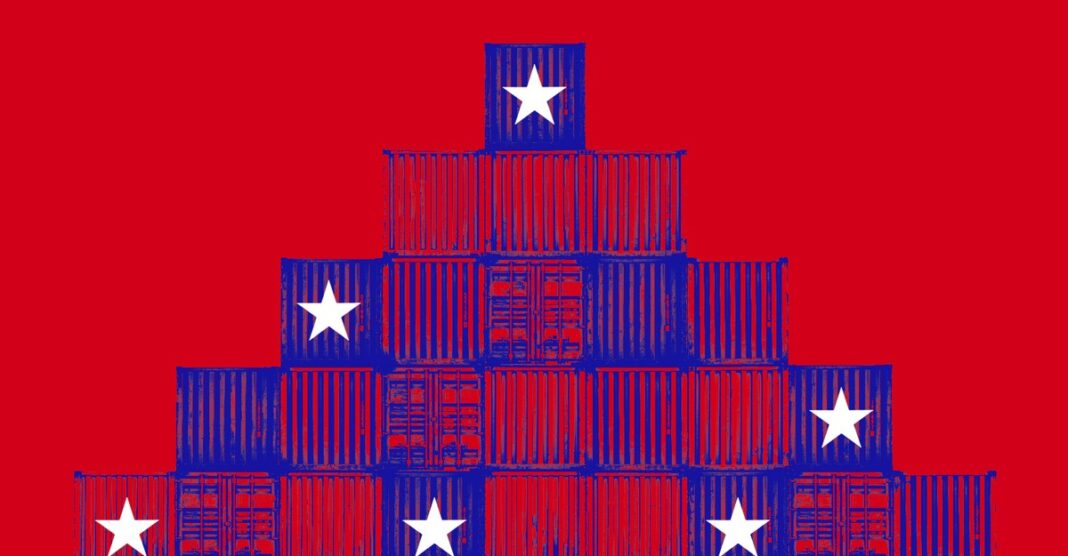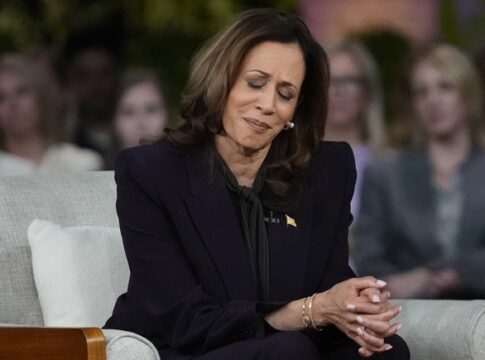Donald Trump’s proposal to impose tariffs as high as 60 percent on imports from China, and a global tariff of 10 to 20 percent, takes the right approach to addressing globalization’s failures—but it has drawn resounding mockery from economists, and, in turn, from the mainstream media. “Trump Is Proposing a 10% Tariff. Economists Say That Amounts to a $1,700 Tax on Americans,” a representative CBS News headline declared in June.
At a moment when the cost of living is consistently one of voters’ top issues, the message is clear: A vote for Trump is a vote for inflation. But in making that argument, economists are abandoning some of their most basic analytic principles.
Their first mistake is to consider only the costs of tariffs, and not the benefits. Traditionally, an economist assessing a proposed market intervention begins by searching for a market failure, typically an “externality,” in need of correction. Pollution is the quintessential illustration. A factory owner will not consider the widespread harms of dumping pollutants in a river when deciding how much to spend on pollution controls. A policy that forces him to pay for polluting will correct this market failure—colloquially by “making it his problem.” It imposes a cost on the polluter in the pursuit of benefits for everyone else.
Tariffs address a different externality. The basic premise is that domestic production has value beyond what market prices reflect. A corporation deciding whether to close a factory in Ohio and relocate manufacturing to China, or a consumer deciding whether to stop buying a made-in-America brand in favor of cheaper imports, will probably not consider the broader importance of making things in America. To the individual actor, the logical choice is to do whatever saves the most money. But those individual decisions add up to collective economic, political, and societal harms. To the extent that tariffs combat those harms, they accordingly bring collective benefits.
Some opponents of tariffs ignore those benefits because they don’t believe that manufacturing things domestically matters. For example, Adam Posen, the president of the Peterson Institute for International Economics, has called Trump’s proposal “lunacy” and “horrifying.” But he has also dismissed concern for American manufacturing as “the general fetish for keeping white males of low education outside the cities in the powerful positions they’re in.” Similarly, Michael Strain, the head economist at the American Enterprise Institute, believes that tariffs “would be a disaster for the U.S. economy.” In his view, the United States cannot be a manufacturing center again, “and we should not want to be.”
These arguments may be internally coherent, but they are wrong. As the fallout from globalization has illustrated, manufacturing does matter. It matters for national security, ensuring both the resilience of supply chains and the capacity of the defense-industrial base. It also matters for growth. “Countries grow based on the knowledge of making things,” Ricardo Hausmann, the director of the Growth Lab at Harvard, has said. “It’s not years of schooling. It’s what are the products that you know how to make.”
Manufacturing drives innovation. As the McKinsey Global Institute has noted, the manufacturing sector plays an outsize role in private research spending. When manufacturing heads offshore, entire supply chains and engineering know-how follow. The tight feedback loop between design and production, necessary to improvements in both, favors firms and workers positioned near the factory floor and near competitors, suppliers, and customers. And the rudimentary matters as well as the advanced: When Apple tried to make its high-end Mac Pro in Texas, the effort foundered on a paucity of screws.
Production in the physical economy, whether manufacturing or agriculture or resource extraction, also has an outsize effect on economy-wide productivity growth. It anchors local economies in a way that personal services cannot. It preserves economic balance, so that trade is genuinely trade, instead of a lopsided exchange of cheap goods for financial assets.
Contrast economists’ disdain for tariffs with their enthusiasm for carbon taxes. Taxing carbon would make many things more expensive for consumers, but economists embrace it as an elegant way to reduce emissions. Imposing a cost on a category of economic activity cannot be inherently foolish in one case (tariffs) and brilliant in another (carbon taxes). The question must be whether imposing that cost would be worth the benefits that it brings.
The second big trap economists fall into when discussing tariffs is an obsessive and uncharacteristic focus on short-term consequences. In most situations, economists encourage people to think about long-term impacts, taking into account how the various affected parties will react to a policy and adjust over time. Will a free-trade deal cause factories to close? Yes, economists concede—but in the long run, they argue, the efficiency gains created by free trade will lead to new and better jobs.
Strangely, economists have little patience for assessing tariffs in the same way. A 2018 report by the Tax Foundation, for example, models tariffs as a tax on American manufacturers. Its authors emphasize the new tax’s drag on growth, but ignore even the possibility that higher import prices might encourage investment in domestic production. The equivalent would be modeling a carbon tax as a corporate tax increase and then declaring that it does nothing to reduce carbon emissions.
Another illustration comes from the University of Michigan economist Justin Wolfers, who recently posted a chart on X illustrating laundry-equipment prices immediately following the imposition of tariffs in early 2018. According to Wolfers, “Trump raised the tariff on washing machines by about 9%-pts and the price of laundry equipment rose by about 9%,” demonstrating that the tariff “was an impressively destructive policy.”
When economists account for a tariff’s full range of effects, however, the picture changes dramatically. For example, researchers at UCLA studying tariffs imposed on China in 2018 estimated that higher import prices were costing the U.S. economy $51 billion annually. But with a “general equilibrium” model that attempted to account for the economy’s response, that estimate fell by 85 percent and became statistically indistinguishable from zero. “We find substantial redistribution from buyers of foreign goods to U.S. producers and the government,” they concluded, “but a small net effect for the U.S. economy as a whole.” If this were in turn to prompt greater investment in domestic production, the net effect might eventually turn positive.
Which brings us back to washers and dryers. If we extend the data a bit further, through the end of 2019, the higher prices completely vanish. (They spike again in 2020, after the pandemic begins wreaking havoc upon global supply chains.) This could be because Samsung and LG brought U.S.-based factories online after the tariffs took effect, expanding domestic supply. The LG plant has now become the first American appliance plant recognized by the World Economic Forum as a “Lighthouse Factory” at the cutting edge of advanced manufacturing. More recently, LG has announced a new $3 billion investment to build a factory in the same town to produce electric-vehicle-battery components.
The story is reminiscent, on a smaller scale, of what happened when the Reagan administration negotiated import quotas on Japanese automobiles, which in the 1980s posed an existential threat to Detroit. Halting any further growth in imports did cause the price of the imported cars to increase initially by 5 to 10 percent. But it also caused the Japanese automakers to make enormous investments in building production capacity in the American South—first assembly plants, then entire supply chains, and eventually research and development facilities as well. Innovation, recall, follows manufacturing. Within just a few years, the quotas were lifted because they were not needed. Prices had returned to normal, and imports no longer flooded the market. The cars were being made in the U.S. by American workers.
Finally, in assessing a tariff’s costs, a holistic analysis must consider where the money goes. The peculiar assumption underlying many anti-tariff arguments is that tariff revenue simply disappears. “If a million people each pay $5 extra in tariffs to save one factory job, that’s $5 million per job,” hypothesizes the policy journalist Matt Yglesias. The reductio ad absurdum of this mindset appears in the Tax Foundation’s model, which not only refuses to consider how tariffs might affect economic activity, but also ignores the value of any tariffs collected. As far as its estimates for growth and employment are concerned, tariff revenue might as well be set on fire.
In fact, if 1 million consumers each pay a $5 tariff, $5 million has not been set on fire—it has moved from their pockets to the U.S. Treasury. The nation is not necessarily any richer or poorer. Some other tax could be reduced by $5 million. The $5 million could be rebated to consumers. It could be invested in some other activity—say, building a new bridge—that might have benefits greater than the cost.
If none of that happens, the money would reduce the federal deficit and the need for borrowing. This would be no small thing given the federal government’s current fiscal crisis. Most people of common sense and good faith agree that tax revenue needs to increase and that spending needs to decrease. An oft-cited letter from 16 Nobel Prize–winning economists expressing their concerns about a second Trump administration emphasizes “a worry that Donald Trump will reignite this inflation, with his fiscally irresponsible budgets.” But if fiscal responsibility is the concern, shouldn’t the fact that a tariff that could raise hundreds of billions of dollars in annual revenue merit some mention?
To be clear, tariffs do impose costs that are not captured as revenue. One of these is what economists call “deadweight loss,” created when resources are used less efficiently than they could be. Damage is done when a consumer who would have benefited from a $30 toaster chooses not to buy one for $33. A second cost appears as consumers switch to domestic options that are more expensive. The consumer who buys the $32 toaster made in America pays the extra $2, but the government collects no extra revenue.
Still, the share of the $32 purchase price that would once have gone to a Chinese factory and its workers now goes to an American firm and its workers instead. It pays American taxes and supports American families in American communities. And as the cases of laundry machines and Japanese cars underscore, when firms have incentives to invest in the United States, American workers prove every bit as capable as foreigners of producing efficiently and driving costs down. The standard anti-tariff narrative ignores all of this.
Protectionism can go too far: Insulating firms from any concern about foreign competition could lead to stagnation. Completely foreclosing access to imported components would make domestic production harder. But public policy is about trade-offs, and the trade-offs presented by tariffs have been well understood for centuries. The United States relied upon high protective walls to develop its own industrial base as it became the world’s foremost economic power in the first half of the 20th century. Asian nations likewise drove their own export-led growth with both industrial policy and tariffs. Most prominently, China has used every trade barrier possible in pursuit of global manufacturing dominance. Conversely, the U.S. saw its industrial base collapse and its trade deficit explode once it left its own market unprotected and welcomed China into the World Trade Organization.
In Economics, the industry-defining textbook first published in 1948, the Nobel laureate Paul Samuelson argued aggressively for free trade. He did not, however, deny that tariffs work; under the heading “Beggar-Thy-Neighbor Policies,” he listed the many ways that policies like “protective tariffs” could help “create a favorable balance of trade.” Rather, Samuelson urged that “any intelligent person who agrees that the United States must play an important role in the postwar international world will strongly oppose the above policies,” because to do otherwise would be to “attempt to snatch prosperity for ourselves at the expense of the rest of the world.” As C. Fred Bergsten, the founding director of the Peterson Institute, acknowledged in 1971, “The economic argument was always marginal” for free trade. “It was the foreign policy case which provided the real impetus for liberal trade policies in the United States in the postwar period.”
Whether America should focus more on domestic or global prosperity, on the lowest possible prices or on long-term growth and industrial strength, are questions on which reasonable minds may differ. They are not, however, questions that economists can answer. In fact, they are precisely the sorts of questions best left to politicians and the voters who elect them.
Support for this project was provided by the William and Flora Hewlett Foundation.



